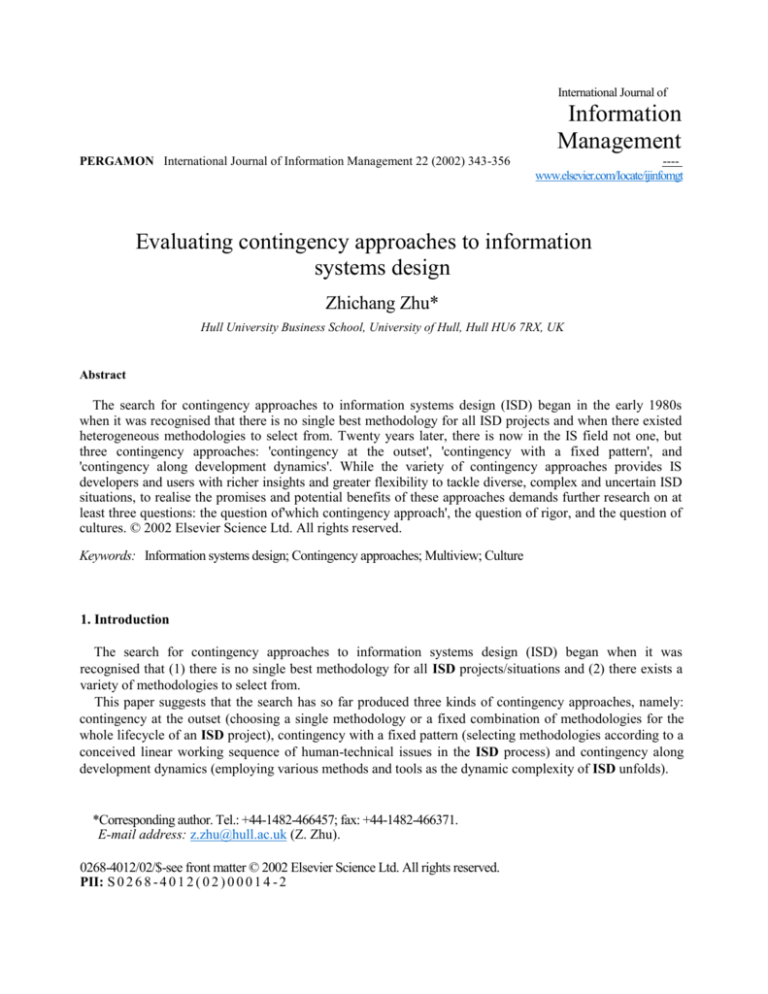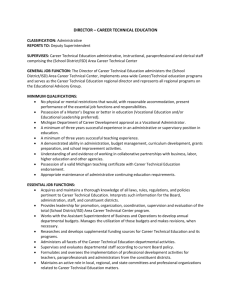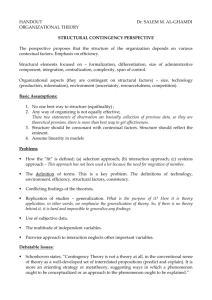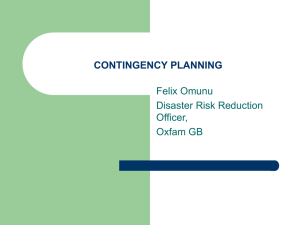
International Journal of
Information
Management
PERGAMON International Journal of Information Management 22 (2002) 343-356
---www.elsevier.com/Iocate/ijinfomgt
Evaluating contingency approaches to information
systems design
Zhichang Zhu*
Hull University Business School, University of Hull, Hull HU6 7RX, UK
Abstract
The search for contingency approaches to information systems design (ISD) began in the early 1980s
when it was recognised that there is no single best methodology for all ISD projects and when there existed
heterogeneous methodologies to select from. Twenty years later, there is now in the IS field not one, but
three contingency approaches: 'contingency at the outset', 'contingency with a fixed pattern', and
'contingency along development dynamics'. While the variety of contingency approaches provides IS
developers and users with richer insights and greater flexibility to tackle diverse, complex and uncertain ISD
situations, to realise the promises and potential benefits of these approaches demands further research on at
least three questions: the question of'which contingency approach', the question of rigor, and the question of
cultures. © 2002 Elsevier Science Ltd. All rights reserved.
Keywords: Information systems design; Contingency approaches; Multiview; Culture
1. Introduction
The search for contingency approaches to information systems design (ISD) began when it was
recognised that (1) there is no single best methodology for all ISD projects/situations and (2) there exists a
variety of methodologies to select from.
This paper suggests that the search has so far produced three kinds of contingency approaches, namely:
contingency at the outset (choosing a single methodology or a fixed combination of methodologies for the
whole lifecycle of an ISD project), contingency with a fixed pattern (selecting methodologies according to a
conceived linear working sequence of human-technical issues in the ISD process) and contingency along
development dynamics (employing various methods and tools as the dynamic complexity of ISD unfolds).
*Corresponding author. Tel.: +44-1482-466457; fax: +44-1482-466371.
E-mail address: z.zhu@hull.ac.uk (Z. Zhu).
0268-4012/02/$-see front matter © 2002 Elsevier Science Ltd. All rights reserved.
PII: S 0 2 6 8 - 4 0 1 2 ( 0 2 ) 0 0 0 1 4 - 2
344
Z. Zhu I International Journal of Information Management 22 (2002) 343-356
The development of contingency approaches in such a historical order is not accidental but was
informed by the failures (and successes) in ISD practice in the last twenty years, as well as by
advances in other disciplines such as sociology, organisation studies, cognitive sciences, systems
and management sciences (see, e.g., Burns & Stalker, 1961; Child, 1984; Flood & Jackson, 1991;
Galbraith, 1973; Kast & Rosenzweig, 1981; Lawrence & Lorsch, 1969; Perrow, 1973; Pugh &
Hickson, 1976; Thompson, 1967).
This paper is not particularly concerned with the wider debate since the 1970s on the
contingency approach to organisational management in general (for an introduction to that
significant debate see, e.g., Donaldson, 1985, 1995, 2001); rather, it will mainly address the ongoing search in the field of information systems for flexible, rigorous and workable design
approaches.
Further, the paper will not present the details of each contingency ISD approach (interested
readers may consult related materials listed in the references). The major objective of the paper is
to bring together and present to the IS community an overview of the variety of such approaches,
to surface their assumptions, to analyse similarities and differences, and to suggest directions for
further research.
2. Contingency at the outset
As early as 1981, it was established that one serious deficiency in ISD is the lack of recognition
that different projects require different development approaches. No longer could developers apply
the same development methodology to all ISD projects, systems or situations. The ability to choose
the most appropriate methodology or a combination of methodologies to fit a particular case was
seen as increasingly important (McFarlan, 1981).
The issue of selecting methodologies became more realistic and urgent when the prototyping
methodology became available in the early 1980s in addition to the more traditional system life
cycle methodology (SLCM). It is further claimed that there was a third methodology: a 'mixed
methodology' that integrated 'the best' of the two methodologies—SLCM and prototyping (Alavi,
1984a, b; Alter, 1977; Boar, 1984; Dennis, Burns, & Gallupe, 1987; Earl, 1982; Gorry & Scott
Morton, 1971; Martin, 1982; Naumann & Jenkins, 1982; Naumann, Jenkins, & McKeen, 1980).
The major rationale behind the favouring of combined methodologies at that time was usually that
complementary use of prototyping might help clarify user requirements, especially during the
initial analysis phase of the formal SLCM process (Alavi, 1984a, b; Gorry & Scott Morton, 1971).
As selecting methodology(ies) became realistic and necessary, approaches that assist and guide
such a selection needed to be, and indeed have been, sought. These approaches have, since then,
often been called contingency approaches; some prefer other names, e.g., 'situational approaches'
(Saarinen, 1990).
The type of contingency approaches available at that time reflected an assumption that it is
possible and necessary to classify system (project) types and to match them with corresponding
development strategies. I call this kind of approach 'contingency at the outset', since it emphasises
(1) selecting a single methodology or a fixed combination of methodologies before developers
begin their project, and (2) subsequently following the same selected methodology or combination
Z. Zhu i International Journal of Information Management 22 (2002) 343-356
345
throughout the whole project process (see Davis, 1982; Gorry & Scott Morton, 1971; Naumann &
Davis, 1978; Naumann et al., 1980).
The best-presented contingency approach of this kind might be Burns and Dennis (1985) and
Louadi, Pollalis and Teng's (1991) two-dimensional framework (illustrated in Fig. 1). The advocates
of this framework consider uncertainty and complexity to be inherent characteristics of the
development of information systems and therefore propose to classify system types according to
these two dimensions: project uncertainty and project complexity. Along the first dimension, they
use three contingencies to determine project uncertainty: degree of structuredness, degree of usertask comprehension and degree of developer-task proficiency, while along the second. dimension,
they use four contingencies to determine project complexity: project size, number of users, volume
of new information, and complexity of new information production (Davis, 1982; Davis & Olson,
1985; Ginzberg & Ariav, 1986; McFarlan, 1981; Naumann & Davis, 1978).
According to the conceived 'high' and 'low', complexity and uncertainty, then, transaction
processing systems (TPS), information reporting systems (IRS), end-user developed applications
(EUDA) and decision support systems (DSS) are located as representatives in the four boxes of the
two-dimensional framework.
It is further suggested that, for one thing, the greater the uncertainty of a project, the greater the
need to use iterative requirements determination strategies such as prototyping; for another, the
more complex a system, the greater the appropriateness of a structured, SLCM-like, methodology.
Based on the interaction of the two dimensions, the advocates argue, high complexity-low
uncertainty projects (e.g., TPS) should be tackled by SDLC complemented by Level-1 prototyping
(prototyping user interfaces), high complexity-high uncertainty projects (e.g., IRS) by SDLC
complemented by Level-2 prototyping (prototyping user interfaces as well as record and file
interactions), low complexity-low uncertainty projects (e.g., EUDA) by Level-3 prototyping
throughout (prototyping from the beginning to the final system), low complexity-high uncertainty
projects (e.g., DSS) by Level-3 prototyping complemented by SDLC (for the 'levels' of prototyping
see Cerveny, Garrity, & Sanders, 1985; Johnson, 1983).
The 'contingency at the outset' approach provided an urgently needed rationale and model for
choosing ISD methodologies (SLCM, prototyping, and various combinations of the two) for
different systems types. There are, however, two inherent problems in it. First, the approach is
fundamentally technology-oriented, lacking a 'people focus', a crucial factor for successful ISD
TPS
IRS
SDLC complemented by
Level-1 Prototyping
SDLC complemented by
Level-2 Prototyping
EUDA
DSS
Level-3 Prototyping
throughout
Level-3 Prototyping
complemented by SDLC
Low
High
Uncertainty
Fig. 1. A two-dimensional model for selecting a methodology at the outset (source: adopted from Louadi et al., 1991;
Burns & Pennies, 1985).
346
Z. Zhu I International Journal of Information Management 22 (2002) 343-356
(McLeod, 1992). Second, IS projects may take on different characteristics as they progress,
rendering a choice at the outset unviable (Avison & Taylor, 1997). Due to these deficiencies, it has
been found (Saarinen, 1990), that organisations often choose methodologies 'inconsistently' with
the recommendations from contingency approaches of this sort.
3. Contingency with a fixed pattern
The best-known form of this second kind of contingency approaches, particularly in the UK, can
be found in Multiview (Avison & Wood-Harper, 1990, 1991). Multiview can be seen as a
development based on a conscious reflection on the deficiencies of 'contingency at the outset'.
From the Multiview perspective, complex situations are usually so because of the mix of human,
social and organisational complexity as well as technical difficulties that underlay the ISD process.
Therefore, Multiview suggests, techniques and tools should be chosen according to particular
problem situations and issues in ISD—not at the outset, but at each individual stage, of a project.
Indeed, the Multiview five-layer framework and five-stage methodology manifest an effort to
combine differing tools, techniques, methods, models, paradigms, 'hard' and 'soft', human-focusing
and technology-oriented, etc., to assist in dealing with dominant issues at different ISD stages.
Multiview directs developers' attention to five key questions: (1) How is the computer system
supposed to further the aims of the organisation installing it? (2) How can it be fitted into the
working lives of the people in the organisation that are going to use it? (3) How can the individuals
concerned best relate to the machine in terms of operating it and using the output from it? (4) What
information system processing function is the system to perform? (5) What is the technical
specification of a system that will come close enough to doing the things that have been written
down in the answers to the other four questions?
Accordingly, the five Multiview stages are: (1) analysis of the human activity systems, (2)
analysis of the information (entities and functions), (3) analysis and design of the socio technical
system, (4) design of the human-computer interface, and (5) design of the technical aspects.
The order of these stages is, the advocates claim, influenced respectively by the advanced works
in sociology and systems-management sciences, as well as by more conventional, structured ISD
approaches, e.g., action research (Checkland & Scholes, 1990), ETHICS (Mumford, 1995), rapid
application development (Martin, 1991), SSADM (Ashworth & Goodland, 1990) and business
systems planning (IBM, 1975).
Compared with 'contingency at the outset', Multiview stresses that (1) human issues are as
crucial as technical design, (2) no single methodology can handle them all, therefore, (3) diverse
methods are needed, and (4) different methods should be chosen and employed according to major
issues in different stages and situations, not to the 'system type' of a project as a whole (Hg. 2).
Obviously, Multiview intends to provide developers with greater flexibility for dealing with
diverse ISD situations, since the approach does not require developers to define the characteristics
and hence the 'system type' of a project at the outset, a task becoming more and more difficult and
unrealistic given the increasing uncertainties and complexities in the development environment, in
the 'system' itself, and in the knowledge, skills, cognitive abilities and power relations of and
Z. Zhu I International Journal of Information Management 22 (2002) 343-356
Inter-i
347
tionships
->
Analyse
human activity
Fig. 2. Multiviewl; a five-stage methodology (source: adopted from Avison & Wood-Harper, 1991).
among developers, as well as end-users. Therefore, the intention of Multiview should be very much
welcomed.
The problem of Multiview, however, lies in the 'waterfall model' in its linear conception of the
working sequence of human and technical issues. While Multiview suggests employing methods
contingently according to different issues, i.e., social, organisational, human, or technical, its image
of the working of these issues is not so contingent, but static. In Multiview, the issues, problems,
tasks and methods are arranged always along the same, prescribed, fixed path.
The linear image is not the result of a misreading of the approach by methodology users, but
pushed forward clearly and forcefully by the advocates themselves, in a manner that can hardly be
mistaken or ignored. As recently as 1995, it was claimed that
Multiview ... incorporates these ['soft'] ideas as a first stage towards developing a computer
information system, and later stages are more influenced by a 'hard' systems viewpoint. ... The
five stages move from the general to the specific, from the conceptual to hard fact and from issue
to task (Avison & Fitzgerald, 1995, p. 42 and p. 377).
As real ISD situations are hardly as well-ordered as this image describes, it is not surprising that
the recommended Multiview procedure has invited questions and criticism (see, e.g., Jackson,
1992, 1997).
To overcome this difficulty, or, to become more 'contingent', the advocates have recently
'redefined' their approach. The result is Multiview2 (Avison, Wood-Harper, Vidgen & Wood,
1996). In Multiview2, 'the five stages have been reduced to a four-box structure' (Avison & Taylor,
1997, p. 78), which can be illustrated in Fig. 3.
It is not clear whether the word 'reduced' can be understood as 'replaced'. What is clear is that, in
this 'reduced' form, 'Multiview offers an exploratory though perhaps not systematic guide to any
information systems development intervention5 (Avison & Taylor, 1997, p. 79).
In other words, Multiview is no longer a methodology but merely a 'framework' since, by
definition, a methodology should have, as a key component, distinct procedures for action, as the
Multiview advocates themselves once agreed—'[a methodology is] a system of procedures,
techniques, tools and documentation aids ...' (Avison & Fitzgerald, 1995, p. 10; as cited in Avison
& Taylor, 1997, p. 73).
348
Z. Zhu I International Journal of Information Management 22 (2002) 343-356
Organisational
analysis
Sociotechnical
analysis &
design
Information
systems
development
Technical
design &
construction
Fig. 3. Muitiview2: a four-box framework (source: adopted from Avison & Taylor, 1997).
Actually, there are more confusions regarding 'what Multiview is', even in the advocates' own
minds. Is it an approach, a methodology, a framework, or merely a metaphor (see, for example,
Avison & Wood-Harper, 1991; Avison & Taylor, 1997; Watson & Wood-Harper, 1995)?
Sometimes, Multiview is said to be all these 'things', albeit one at a time. On some other occasions,
it is argued to be not a methodology at all (for the debate on these confusions see, e.g., Jackson,
1992, 1997; Watson & Wood-Harper, 1995).
In the view of this author, the confusions around Multiview cannot be easily clarified by a
'reduction' from stages into boxes, or by playing of words (e.g., definitions of those 'things'). As
long as one holds an isolationist and static view of human vs. technical issues, there is no any other
options but to choose either a prescribed, fixed, 'social issues first—technical design later'
sequence, or no methodological procedures at all.
4. Contingency along development dynamics
An approach has recently emerged in the East that presents what I call 'contingency along
development dynamics', in that the approach moves a further step to admit that various issues that
shape ISD do interact continuously with each other in an unpredictable manner, which, like it or
not, can only be appreciated and tackled at each unique development moment, as the complexity of
ISD unfolds, rather than in a prescribed sequence.
The approach is called Wuli-Shili-Renli, or WSR for short. Li, the key concept of the approach,
is in Chinese both a noun and a verb. When translated into English, li means essence, organism,
order, logic, pattern, tendency, principle, reason, reasoning, investigating, engaging, managing,
responding, coordinating, caring, etc. Li also denotes human knowledge about all these 'things',
actions and interactions.
There are multiple lis that are different manifestations of the general Li—the Tao. Wuli presents
regularities and principles that form and govern the material-technical aspects of the world. Shili
denotes the psycho-cognitive dimensions of human activity, i.e., the ways individuals as well as
groups choose to see, to think, to model, to present and to act. Renli highlights the social-political
Z. Zhu I International Journal of Information Management 22 (2002) 343-356
349
relations in human life, i.e., patterns of motivation, negotiation, communication, power structuring,
value shaping, love and hate, confrontation and co-operation, etc.
The WSR theme has been deeply ingrained in the Chinese life. It can be traced back to an ancient
Confucian classic, Da Xu (The Great Learning), in which 'Eight Wires' were set for the Chinese as
a Bible for acquiring sageliness within and kingliness without. The Eight Wires are: investigating
things, extending knowledge (in the WSR reconstruction these two are grouped into wuli), making
the thought sincere, rectifying the mind, cultivating the self (these three are grouped into shili),
regulating the family, ordering the state and harmonising the world (these three are grouped into
renli). The Eight Wires and hence the WSR theme, commonly held by the Chinese, thus have
ontological, epistemological, methodological as well as moral implications.
To WSR, all real-world situations and hence ISD projects can be pragmatically seen as
conditioned by the continuous interplay of wuli (relations with the world), shili (relations with the
mind) and renli (relations with others). In conducting projects and doing management, we humans
are, ideally, inquiring into three action domains: to investigate and model wuli, to be concerned
with and reflect on shili, to coordinate and harmonise renli. Rather than replacing the domination of
wuli with any other domination, WSR urges participants to embrace all wuli, shili and renli
considerations, concerns, models and perspectives into a communicative dialogue, and accordingly
search for appropriate methods to address various lis.
Differentiated as they are, lis are always interacting with and ever conditioning each other. In
ISD terms, technical problems and social issues usually penetrate and transform each other. Wuli,
e.g., computer networks and the Internet, continuously shape how we humans interact with the
world as well as among ourselves. Renli, e.g., power structures, dictate not only our ethical
conceptions of how IS should work but also our 'technical' decisions on what equipment to
purchase, where, from whom and why, etc. Our conceptual ways of situation-framing, sensemaking, meaning-sharing as well as value-shaping, i.e., shili, are underlain by technological (wuli)
and power (renli) conditions, as much as they are transformed by new knowledge we obtained
during our learning process (Fig. 4).
Knowing Wuli
Sensing Shili
Material-technical
What is...
Investigating
resources/
conditions
kv\
Caring for Renli
Psycho-cognitive
Social-political
Howto...
/p^L Reflecting on
\a) Perspectives/
models
Shall we...
•
Coordinating
Humanrelations
Fig. 4. The philosophy of WSR (source: Zhu, 2001, p. 76).
350
Z. Zhu I International Journal of Information Management 22 (2002) 343-356
It is not new, in the East as well as in the West, to see ISD in particular and human activities in
general through a multidimensional model (see, for example, Churchman, 1979; de Raadt, 1989,
1995; Linstone, 1984, 1999; Mitroff & Linstone, 1993). What is new in WSR is the emphasis on
the unpredictably dynamic interplay of the multiple dimensions, perspectives and actions.
Metaphorically, W, S and R are seen as bubbles. Like the dancing up of bubbles in water, the
behaviours, interactions and mutual influences of and among W, S and R are highly uncertain,
unpredictable, always breaking away from any sort of prescribed sequential order. It is neither
realistic nor productive to deal always with a single particular kind of issue first and with other
kinds later. Fixed orders can only be found in textbooks, not in the real world.
Methodologically, to handle this 'bubble dynamics', WSR does not adopt the established and
fashionable (in the West) 'social-technical' or 'soft-hard' sequence. Rather, ISD activities in WSR
are arranged based on a deep-underlying pattern, according to which humankind are concerned
with, try to answer, and subsequently seek plans and take actions with regard to a few key
questions.
First, participants in a concrete situation, motivated by desire for change, improvement, the
reduction of uncertainty, etc., are encouraged to express what they feel and what they want, asking
the question, 'what do we need'? Next, participants focus on investigating what resources they can
deploy and what constraints they have to tackle in order to realise the expressed desires, answering
the question, 'what do we have'? Then, by comparing the desired and the existing, users may be
able to specify what is feasible, discussing the question, 'what shall we have'? The following stages
are concerned with converting the feasible requirements into a structured solution (what shall we
do?), putting the solution plan into operable configurations (how shall we do it?), and evaluating
the outcome obtained, the methodology employed, and what participants have learnt from the
whole process (how well have we done?). The element of 'coordinating relations' demands that the
discussion and tackling of those questions should be conducted in a collective way, collective in
terms of resources, expertise, opportunities, agendas, etc.
Thus, in WSR, the wuli-shili-renli interplay on the one hand and the ISD operational stages on
the other are conceived as constituting a //-stage matrix. Based on the matrix, developers are
guided to go through the ISD process in a spiral manner, always preparing to tackle W, S, and R
simultaneously at any ISD moment, not in a linear lrenli first-ww/i later' order (Fig. 5).
WSR even suggests that an IS solution should not be presumed at the outset. Rather, participants
are encouraged to engage in each problem situation such that any project is but a small round of the
wider, never-ended, spiral general problem-solving (GPS), i.e., organisational management,
process. Projects thus do not necessarily begin as ISD ones, and logically the WSR methodology
should not take an ISD form or language by default. Only when participants reach an appreciation
that an IS solution is needed and that a formal ISD methodology is meaningful, should the GPSISD transformation be intentionally pursued. The transformation is possible because, to WSR,
general management (GPS) and ISD processes are but varying manifestations of a similar
underlying logic (Fig. 6 and Table 1).
Then, due to the specific requirements of ISD, when transformed into an ISD form, each WSR
stage can be further divided into several more manageable steps, which can be intentionally geared
towards incorporating available activity elements from various ISD methodologies. For example,
the 'information needs appreciation' stage can be arranged into three steps: exchanging feelings and
concerns, expressing desires, exploring possible solution options; the condition analysis stage
Z. Zhu I International Journal of Information Management 22 (2002) 343-356
Coordinating
relations
W
S
351
R
Understanding desires
Investigating conditions
Formulating objectives
Creating models
Implementing proposals
Evaluating performance
Fig. 5. The WSR Li-stage matrix.
Wltat do we need?
&(*
How well have we done? <t^y
Wftat do we have?
evaluating
performances
How shall we do it?
nplementing
\ LJL\ J/"^ \
formulating
proposals
/
'
/
f^Vu u
I------- — ---- -f>
\
objectives
x
creating models
General management form
Information systems design form
Fig. 6. Isomorphism: the GPS and ISD forms of the WSR methodology (source: Zhu, 2001, p. 82).
into four steps: planning investigation, framing situations, discussing findings, writing reports; the
system design stage into six steps: logical design, physical design, testing design, conversion
design, training design, evaluation design, etc.
In each WSR stage or sub-step, participants should, ideally, be able to access whatever methods,
techniques and' tools they consider appropriate. For example, information needs appreciation can
be assisted by techniques and tools such as interviews, questionnaires, brainstorming, rich pictures,
conceptual models, data flow diagrams, flow charts, prototyping,
352
Z. Zhu I International Journal of Information Management 22 (2002) 343-356
Table 1
Underlying logic, GPS and ISD forms of WSR (source: Zhu, 2001, p. 83)
Underlying logic
GPS form
ISD form
What do we need? What
do we have? What shall
we have? What shall we
do? How shall we do it?
How well have we done?
Understanding desires
Investigating conditions
Formulating objectives
Creating models
Implementing proposals
Evaluating performance
Information needs appreciation
Conditions analysis
Requirements specification
Systems design Systems
implementation Systems
evaluation
Coordinating wuli-shili-renli relations
demonstrations from suppliers, visiting organisations in the same industry, seminars by managers,
professionals, users, etc. At the beginning, no method should be excluded; at the end, no method
by itself can be sufficient. Users are encouraged creatively to apply various methodologies, in
whole or in parts, as long as they consciously surface and make transparent the basic assumptions
of those methodologies, models, techniques and tools. Indeed, participants are urged to take WSR
as merely a starting point for learning and empowering. As they become familiar with the
multidimensional and dynamic conception of ISD, users are encouraged to move beyond WSR, so
as to create a unique methodology for each ISD situation (for the WSR philosophy and ISD
applications see Zhu, 2000, 2001, 2002).
5. Unanswered questions
The task set for this paper is modest—to bring together, and inform the IS community about, the
variety of existing contingency approaches. In doing so, the paper may have raised many
unanswered questions, of which three are briefly addressed below.
5.1. The question of which contingency approach?'
The core message of this paper is that, in the IS field, we now have not only a variety of ISD
methodologies to select from, but also a variety of contingency approaches that intend to guide
how those methodologies are selected, combined and applied. This second variety provides IS
developer and users with more choices, while at the same time demanding considerations and
decisions at a higher conceptual level, the 'meta-contingency' level. Which contingency approach
should we adopt? Is one of the approaches always more meaningful than the other? If yes, which
one, and why? If not, should we adopt the contingency approaches contingently in different ISD
situations? If so, what are the determining contingencies that we should look at in making such
decisions? Or, shall we not necessarily pick up one contingency approach while turning down the
others, but draw the 'best insights' from all these approaches, even for the same project, so that our
ISD becomes better informed?
Z. Zhu 1 International Journal of Information Management 22 (2002) 343-356
353
5.2. The question of rigour
The purpose of contingency approaches is to provide developers with flexibility for tackling
complexity and uncertainty in ISD. However, flexibility alone may not necessarily be the solution;
it can be the path to other problems. It might become an invitation to anarchism. Without being
checked, 'the very promotion of flexibility can be seen as at odds with the concept of rigour and
hence even with the idea of "method" itself (Rackley, Webb & Betts, 1998, p. 170).
The more flexibility an approach provides, the more challenging the question of rigour might
become. With 'contingency at the outset', once it has been decided which techno logy-oriented ISD
methodology to adopt, rigour is, logically if not practically, no longer a problem: one can, and
indeed must, follow the associated set of principles, procedures, tools and control measures, which
are there exactly to ensure rigour. With 'contingency with a fixed pattern', one obtains, ideally,
increased flexibility, i.e., 'hard' methodologies to solve technical problems as well as 'soft' ones to
manage human issues, at different ISD stages. However, whether an ISD difficulty at hand is a
technical or a human one is largely a subjective judgement usually impossible to be made or agreed
upon in a 'rigorous' manner. As to 'contingency along development dynamics', ISD appears to be
treated more like an artful activity that demands difficult-to-codify-and-measure knowledge, skills
and conducts, rather than as an engineering discipline which should, by definition, be rigorously
controlled. May be, in terms of the previous question, rigour is one of the dimensions in
considering 'which contingency approach'?
5.3. The question of culture
It is interesting to notice that the three contingency approaches were developed in different
cultural contexts: 'at the outset' in North America, 'with a fixed pattern' in Europe, and 'along
development dynamics' in China. Do cultures have a role to play in shaping the 'personalities' of
these approaches?
There may be some patterns to discern. The technical orientation of the 'outset' approach appears
to fit well with the performancism that dominates the industrial culture in North America. It looks
equally natural, given the deep-ingrained, outstanding critical and humanistic spirit in the European
intellectual tradition, that Multiview incorporates human issues, social concerns and organisational,
behavioural factors firmly into the ISD agenda. As to WSR, its 'interconnectedness' view of ISD, its
'bubble dancing' metaphor, its cyclical perception of activities, its preference for user-friendly
language over technical jargon, and so on, seem to reflect the unique temperaments of Confucian
pragmatism and Taoist naturalism. If such an analysis is reasonable, then national cultures can be
another candidate dimension of the 'which contingency approach' question.
Some research has been done on the influence of national cultures on IS. For example,
Martinsons and Westwood (1997) discuss what they call the 'misfit' between management
information systems and the paternalism, personalism and high context communications in the
Chinese business culture. Boisot and Child's (1996) work, although not particularly targeted at the
IS discipline, analyses the tendency in.the Chinese culture to resist the codification of information,
law and regulation, suggesting that the Chinese may take a unique route towards capitalism. So far,
these works have focused exclusively on the relationship between national
354
Z. Zhu I International Journal of Information Management 22 (2002) 343-356
cultures and information systems at the macro level, leaving the micro issue, i.e., the influences of
national cultures on ISD situations and processes, unexplored.
Detailed discussion of these unanswered questions is beyond the target of this paper.
Nevertheless the questions may deserve further research in order to realise the potential benefits of
the variety of contingency approaches.
6. Conclusion
As developers and users face the increasing uncertainty and complexity in ISD situations as well
as the wide range of heterogeneous ISD methodologies, contingency approaches that assist in
selecting, combining and applying appropriate methodologies have been insistently sought. Today,
there has in the IS field developed not one, but a variety of contingency approaches, of which three
are discussed in this paper: contingency at the outset, contingency with a fixed pattern, and
contingency along development dynamics.
The purpose of contingency approaches is to provide flexibility to understand and manage the
complexity and uncertainty in technology, the marketplace, human relations and cognitive
capabilities that shape ISD. However, the promise comes hand-in-hand with challenges. To tackle
these challenges and to realise the potential benefits of contingency approaches, further research is
urgently needed and can begin with three questions: the question of 'which contingency approach',
the question of rigour, and the question of cultures.
Acknowledgements
This paper is a revised and extended version of an invited keynote speech delivered at the GITIS'
2000 (Gulf Information Technology and Information Systems Conference) that is held at Dubai,
UAE, 12-13 March 2000. The author would like to extend his gratitude to the British Council and
the Dubai Chamber of Commerce for their generous sponsorship.
References
Alavi, M. (1.984a). An assessment of the prototyping approach to information systems development. Communications of
the ACM, 27(6), 556-563. Alavi, M. (1984b). The evolution of information systems development approaches: Some
field observations. Bata Base,
75(3), 19-24. Alter, S. (1977). A taxonomy of decision support systems. Sloan Management Review, 19(1), 39-56.
Ashworth, C, & Goodland, M. (1990). SSADM: A practical approach. Maidenhead: McGraw Hill. Avison, D. E., &
Fitzgerald, G. (1995). Information systems development: Methodologies, techniques and tools (2nd ed).
Maidenhead: McGraw-Hill. Avison, D. E., & Taylor, V. (1997). Information systems development methodologies:
A classification according to
problem situation. Journal of Information Technology, 12, 73-81. Avison, D. E., & Wood-Harper, A. T. (1990).
Multiview: An exploration in information systems development.
Maidenhead: McGraw-Hill.
Z. Zhu I International Journal of Information Management 22 (2002) 343-356
355
Avison, D. E., & Wood-Harper, A. T. (1991). Information systems development research: An exploration of ideas in
practice. Computer Journal, 34, 98-112. Avison, D. E., Wood-Harper, A. T., Vidgen, R. T., & Wood, J. R. G. (1996). Multiview;
An exploration in information
systems development (2nd ed). Maidenhead: McGraw-Hill. Boar, B. H. (1984). Application prototyping. New" York: Wiley.
Boisot, M., & Child, J. (1996). From fiefs to clans and network capitalism: Explaining China's emerging economic
order. Administrative Science Quarterly, 41, 600-628. Burns, R. N., & Dennis, A. R. (1985). Selecting the appropriate application
development methodology. Data Base,
J 7(1), 19-23. Burns, T., & Stalker, G. M. (1961). The management of innovation. London: Tavistock. Cerveny, R. P., Garrity, E.
J., & Sanders, G. L. (1985). The application of prototyping to systems development: A
rationale and model. Journal of Management Information Systems, 3(2), 52-62. Checkland, P. B., & Scholes,
J. (1990). Soft systems methodology in action. Chichester: Wiley. Child, J. (1984). Organisation: A guide to
problems and practice (2nd ed). London: Harper & Row. Churchman, W. (1979). The systems approach. New
York: Dell.
Davis, G. B. (1982). Strategies for information requirements determination. IBM Systems Journal, 27(1), 4-30. Davis, G. B., &
Olson, M. H. (1985). Management information systems: Conceptual foundations, structure, and
development. New York: McGraw-Hill. de Raadt, J. D. R. (1989). Multi-modal systems design: A concern for the issues that
matter. Systems Research, 1{\), 725. de Raadt, J. D. R. (1995).. Expanding the horizon of information systems design. Systems Research, 12(3), 185-199. Dennis,
A. R., Burns, R. N., & Gallupe, R. B. (1987). Phased design: A mixed methodology for application systems
development. Data Base, 18(4), 31-37. Donaldson, L. (1985). In defence of organisation theory: A reply to the critics.
Cambridge: Cambridge University Press. Donaldson, L. (1995). American anti-management theories of organisation: A critique of
paradigm proliferation.
Cambridge: Cambridge University Press. Donaldson, L. (2001). The contingency theory of organisations. Thousand Oaks: Sage.
Earl, M. J. (1982). Prototyping systems for accounting, information and control. Data Base, 13(2-3), 39-46. Flood, R. L., & Jackson,
M. C. (1991). Creative problem solving: Total systems intervention. Chichester: Wiley. Galbraith, J. (1973). Designing complex
organisations. Reading, MA: Addison-Wesley. Ginzberg, M.J., & Ariav, G. (1986). Methodologies for DSS analysis and design: A
contingency approach to their
application. Proceedings of 1986 International Conference in Information Systems (pp. 46-56). Gorry, G. A., & Scott Morton, M.
S. (1971). A framework for management information systems. Sloan Management
Review, 13(1), 55-70. IBM (1975). Business systems planning. In J. Cougar, M.A. Colter, & R.W. Knapp (Eds.), Advanced
Systems
Development/Feasibility Techniques, New York: Wiley, 1982. Jackson, M. C. (1992). An integrated programme for critical
thinking in information systems research. Journal of
Information Systems, 2, 83-95. Jackson, M. C. (1997). Critical systems thinking and information systems research. In J. Mingers,
& F. Stowell (Eds.),
Information Systems: An Emerging Discipline? (pp. 201-238). Maidenhead: McGraw-Hill. Johnson, J.R. (1983). A prototyping
success story. Datamation, 251-256. Kast, F. E., & Rosenzweig, J. E. (1981). Organisation and management: A systems and
contingency approach (3rd ed).
New York: McGraw-Hill. Lawrence, P. R., & Lorsch, J. W. (1969). Developing organisations: Diagnosis and action. Reading, MA:
Addison-Wesley. Linstone, H. (1984). Multiple perspectives for decision making. New York: North-Holland. Linstone, H. (1999).
Decision making for technology executives. Norwood, MA: Artech House, Inc.. Louadi, M.E., Pollalis, Y.A., & Teng, J.T.C. (1991).
Selecting a systems development methodology: A contingency
framework. Information Resources Management Journal, 11-19. Martin, J. (1982). Application development
without programmers. Englewood Cliffs, NJ: Prentice-Hall. Martin, J. (1991). Rapid application development.
Englewood Cliffs, NJ: Prentice-Hall.
356
Z. Zhu I International Journal of Information Management 22 (2002) 343-356
Martinsons, G. M., & Westwood, R. I. (1997). Management information systems in the Chinese business culture: An
explanatory theory. Information and Management, 32, 215-228. McFarlan, F. W. (1981). Portfolio approach to information
systems. Harvard Business Review, 59(5), 142-150. McLeod, G. (1992). Managing methods creatively. South Africa Computer
Journal, 7, 131-140. Mitroff, I. I., & Linstone, H. (1993). The unbounded mind. Boston: Oxford University Press.
Mumford, E. (1995). Effective requirement analysis and systems design: The ETHICS method. Basingstoke: Macmillan. Naumann,
J.D., & Davis, G.B. (1978). A contingency theory to select an information requirements determination
methodology. Proceedings of the Second Software Life Cycle Management Workshop, IEEE, New York (pp. 63-65). Naumann,
J. D., & Jenkins, A. M. (1982). Prototyping: The new paradigm for systems development. MIS Quarterly,
6(3), 29^4. Naumann, J. D., Jenkins, A. M., & McKeen, J. D. (1980). Determining information requirements: A contmgency
method for selection of a requirement assurance strategy. Journal of Systems and Software, 7(4), 273-281. Perrow, C. (1973).
Complex organisations: A critical essay (2nd ed). New York: Random House. Pugh, E., & Hickson, D. J. (1976). Organisational
structure in its context. Farnborough; Saxon House and Lexington
Books. Rackley, L., Webb, J., & Betts, J. (1998). Flexibility: Sense or nonsense? In D. Avison, & D. Edgar-Nevill (Eds.),
Proceedings of the UKAIS9S on matching technology with organisational needs (pp. 167-173). Maidenhead:
McGraw-Hill. Saarinen, T. (1990). System development methodology and project success. Information and Management, 19,
183-193. Thompson, J. D. (1967). Organisation in action. New York: McGraw-Hill. Watson, H., & Wood-Harper, T. (1995).
Methodology as metaphor: The practice basis for multiview methodology
(a reply to M.C. Jackson). Information Systems Journal, 5, 225-231. Zhu, Z. (2000). WSR: A systems approach for information
systems development. Systems Research and Behavioural
Sciences, 17, 183-203. Zhu, Z. (2001). Towards an integrating programme for information systems design: An oriental case.
International
Journal of Information Management, 21, 69-90. Zhu, Z. (2002). Towards user-friendly OR: A Chinese experience. Journal of
the Operational Research Society, 53, 137148.
Zhichang Zhu was born in China. His normal education stopped when he was sixteen, year 3 in a secondary school, due to China's
'Cultural Revolution'. Without a first degree, he obtained a M.Sc. in Information Management and a Ph.D. in Management Systems
& Sciences, sponsored by British scholarships. Before moving to universities, Zhichang worked for sixteen years in agriculture,
commercial transportation and telecommunication industries, in China, Singapore, Sri Lanka and Great Britain. Zhichang has
researched in the areas of information systems and knowledge management from a cross-cultural perspective, with over fifty articles
published in, among others, Human Relations, Human Systems Management, International Journal of Information Management,
International Journal of Organisational Analysis, Journal of the Operational Research Society, Systems Research and Behavioural
Science, Systemic Practice and Action Research, Systems Engineering Theories and Practice, Education and Training and a United
Nations encyclopaedia. Zhichang is currently a senior lecturer in management and the director of PhD program at the University of
Hull Business School, a visiting professor at the International East-West University and a visiting research fellow at the Graduate
School of Knowledge Science, Japan Advanced Institute of Science and Technology.







